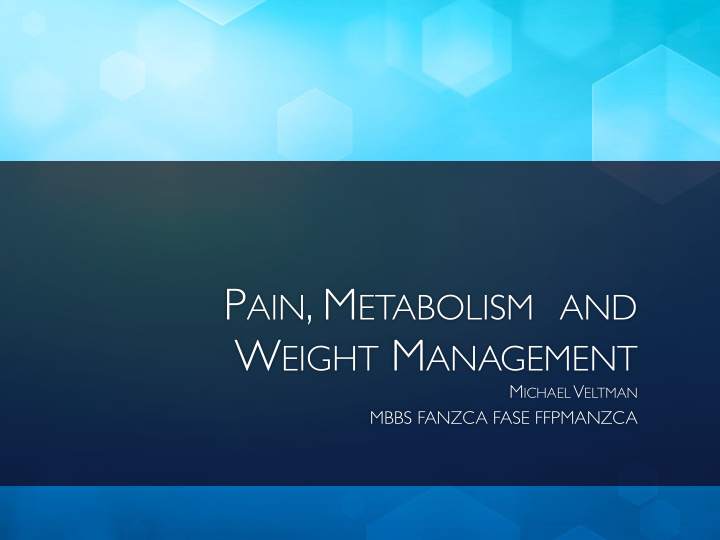



P AIN , M ETABOLISM AND W EIGHT M ANAGEMENT M ICHAEL V ELTMAN MBBS FANZCA FASE FFPMANZCA
O VERVIEW Epidemiology Evidence base for diet Physiology Treatment options
E PIDEMIOLOGY
E PIDEMIOLOGY Chronic pain is a common condition Probably around 20% of the population Some estimates are higher (30-50%) Associated with age.
E PIDEMIOLOGY Incidence of obesity started to rise from around the mid 1970’s Prior to that things were stable. So what happened in the 1970’s?
E PIDEMIOLOGY The idea of “basic foods” was first developed in1972 in Sweden - “Basic Foods” had to be cheap and nutritious - “Supplemental foods” added nutrition missing from basic foods. Rapidly adopted around the world.
E PIDEMIOLOGY Food pyramid evolved - Often driven by agriculture. - Really no evidence base.
P AIN AND O BESITY - R ELATIONSHIP ? Prospective population based cohort study - 78 973 people in Nord-Trøndelag County - 11 years follow up - 1995-6 (Hunt 2) - 2006-2008 (Hunt 3) 37 071 had complete data
W HAT FACTORS PREDATED PAIN ? Increases in number of pain sites independently predicted by: - Anxiety - Depression - Sleeping problems - Obesity For each 3 points of BMI increase, one extra painful site 11 years later.
E VIDENCE B ASE
I TS SIMPLE , RIGHT ? WeightGain ( kg ) = ( Intake − Expenditure )/7000 Doing the math over 40 years: 120 Kg versus 80 Kg (1 kg /year) 19 calories per day difference. So that should be really easy to fix.
E VIDENCE B ASE OF STANDARD TREATMENT ? Diet does work - Hirsch published in 1950’s using diet control - Showed that limiting portions caused weight loss - Showed that metabolism slowed with 10% reduction in weight Admitted to hospital and controlled what people ate. Better in this regard than most published studies on nutrition.
T HE BIGGEST LOSER E AT LESS , MOVE MORE
E VIDENCE FOR D IET Real world diet programs usually get about six months: Eat less, move more.
M ETABOLISM SLOWS DOWN Every single person who entered the biggest loser slowed their metabolism Average was 700 cal/day reduction. Everyone feels awful.
S O HOW DO WE MANAGE OBESITY ? We tell everyone to eat less and exercise more We know that the evidence base is that this will fail Then we blame the patient for failing a treatment we have prescribed that lacked evidence for long term efficacy.
D OES THIS ALWAYS HAPPEN ? So why is bariatric surgery different?
O THER THINGS REGULATE WEIGHT Insulin regulates weight - Type 1 DM presents with weight loss Insulin causes weight gain. - Subcut insulin => lipohypertrophy Insulin causes GLT-4 expression -> Glucose uptake into muscle and fat -> Enhances lipogenesis -> Blocks lipolysis
P HYSIOLOGY
A DENOSINE - P HOSPHATE Adenosine is found in all cells - Part of DNA - Used as an energy store Phosphate ions are added on to hold energy
AMPK, M TOR, HBP Hexosamine biosynthetic pathway (HBP) => Energy sensor AMP Activated Protein Kinase => low energy response -> Activated when ratio of ATP:AMP falls. mammalian Target Of Rapamycin => high energy response -> Activation of this leads to cell growth, division and inflammation
E NERGY SENSING MECHANISMS Low energy - AMPK activates. Cellular function slows down High energy mTOR activates Cells grow and divide. (Normal and cancer cells) Inflammatory effects This is seen in every cell in every complex (multicellular) organism.
W HAT ABOUT HIGHER FUNCTIONS ? Hypothalamic AMPK is a major mediator of energy balance. Activation leads to: - Induced appetite - Decreasing thermogenesis and basal metabolic rate Hypothalamic neurons in the arcuate nucleus release Neuropeptide Y (hunger) Pro-opiomelanocortin (saiety)
D ECREASING H YPOTHALAMIC AMPK Leptin (made in fat cells) Depolarises POMC neurons, stimulates β -endorphin and α -MSH Adiponectin Promotes glucose uptake and FFA oxidation in muscles, reduces hepatic gluconeogenesis, increases brown adipose tissue thermogenesis Has anti-inflammatory properties. Reduced levels of this in obesity and T2DM
D ECREASING H YPOTHALAMIC AMPK GLP-1 Produced by neurons in nucleus solitary tract. suppresses appetite. Inhibits AMPK activation with fasting Insulin Central administration of insulin produces satiety. Insulin resistance in the brain leads to hyperphagia.
I NCREASING H YPOTHALAMIC AMPK - Ghrelin Made in stomach Stimulates appetite via hypothalamic neuropeptide Y Upregulates AMPK in the hypothalamus.
T REATMENT OPTIONS
M EDICATIONS Phentermine (Duromine) - similar to amphetamine - releases dopamine, typically 5-10% body weight loss Significant side effects hypertension, tachycardia rarely stroke, angina, cardiac failure pulmonary hypertension, cardiac valve disease CNS overstimulation GI effects - Nausea and vomiting
B UPROPION /N ALTREXONE (C ONTRAVE ) Combination therapy 6-8% body weight loss (360mg/32mg) Causes activation of POMC neurons, safety Side effects Excitatory effects, risk of seizures. Hypertension, arrythmias Mood elevation (bipolar disease contraindicated)
GLP-1 R ECEPTOR A GONISTS L IRAGLUTIDE Satiety via reduction in hypothalamic AMPK. 5-10% weight loss (up to 13% in some studies) Dosage: 0.6 - 3.0 mg/day subcutaneous injection Side effects - Slowing of GI tract function. Reflux, nausea and vomiting. - Constipation (Rarely diarrhoea) - Flu like symptoms, headache, dizziness. - Hypoglycaemia, rare in non-diabetics
S URGERY Still the gold standard for reducing total body weight Very strong positive effect on diabetic control Gastric bands 20% Gastric sleeve 40% RY bypass 50%
S UMMARY Epidemiology Evidence base for diet Physiology Treatment options
More recommend